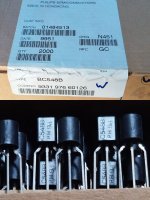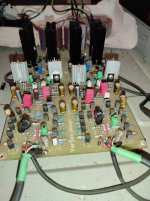That's not anti-static foam - first rule of MOSFETs: full anti-static precautions are required - if that's how the shop sold them that was a huge red flag, the devices could easily have been zapped already.I just bought 4 pcs of 2SK2013 from physical shop in Zagreb (for 6 Euro per piece) which are obvious fakes, Vgs measures 3,6 - 3,8 V instead of around 2 V. Pictures are on this post:
https://www.diyaudio.com/community/...ttle-fb-160watt-amplifier.412261/post-7675832
Maybe this article can shed some more light. It's the current that kills, but the current that runs through the body is dependent on voltage and resisance and especially the latter varies a lot depending on the circumstances. It also varies on the path it takes, through the heart is far more dangerous than (e.g.) into a finger and out the elbow. Time is another important factor.I keep reading different "opinions" about what voltages and currents are "safe", but usually these post do not indicate the details of where the information came from. Is there an authorative text out there that can be relied on? A good old book maybe?
Other than with very low voltages, it's hard to say when one becomes lethal.
In the article, there's a table of currents and reactions. As a young man I received a shock that went from one hand through to the other, so going through the heart. Based on what I remember, it must have been in the 6-30 mA range. Also, I remember not tripping the 30 mA RCD. That was a rather unpleasent experience that I remember for the rest of my life.
Last edited:
Thanks. However, that's just yet another website that Google would also tell me about. What I am looking for is a well substantiated text from a reputable source. When it comes to information about safety and potentially lethal consequences I'd prefer something a bit more than just yet another website with ads and comic movies.Maybe this article can shed some more light.
^ I'm not familiar with this work, but a quick review of the scope of work/synopsis brings this to the forefront as something to consider reading. It may help answer a few questions and lead toward additional resources depending on how deeply you'd like to delve into the subject.
https://www.ncbi.nlm.nih.gov/books/NBK448087/
https://www.ncbi.nlm.nih.gov/books/NBK448087/
Okay,
My official training. Keep your left hand in your pocket. Discharge power supplies, not just off, discharge capacitors and any CRTs. Don't stand in the water.
I'm serious, that was the training. As jitter said, there are so many variables. You can get a heck of a shock at 12 VDC due to inductive kick when something gets disconnected. I did work in the Telecom field, tip and ring guy, as well as DSL (that'll hurt!). My butt set would detect DSL for that reason and others.
I have been shocked by >25 KV (I hate TVs, I didn't even have to touch anything), 1.5 KV a couple times, 450 VDC (about) a few times and 120 VAC many times. Mostly due to circuit failures and voltage showing up where it wasn't supposed to be. My takeaway? Never assume anything.
But don't go looking for a chart. The most accurate information is the current chart. Voltage is highly variable and the current path means everything. Often the injuries sustained by involuntary muscle movement causes more physical damage than the shock, like gashes, scrapes and falls. So there is another dimension to what harm can come from electricity
My official training. Keep your left hand in your pocket. Discharge power supplies, not just off, discharge capacitors and any CRTs. Don't stand in the water.
I'm serious, that was the training. As jitter said, there are so many variables. You can get a heck of a shock at 12 VDC due to inductive kick when something gets disconnected. I did work in the Telecom field, tip and ring guy, as well as DSL (that'll hurt!). My butt set would detect DSL for that reason and others.
I have been shocked by >25 KV (I hate TVs, I didn't even have to touch anything), 1.5 KV a couple times, 450 VDC (about) a few times and 120 VAC many times. Mostly due to circuit failures and voltage showing up where it wasn't supposed to be. My takeaway? Never assume anything.
But don't go looking for a chart. The most accurate information is the current chart. Voltage is highly variable and the current path means everything. Often the injuries sustained by involuntary muscle movement causes more physical damage than the shock, like gashes, scrapes and falls. So there is another dimension to what harm can come from electricity
I can only tell you that in my training to become a technician for a district net operator (DNO) the only hard values that are given are minimum acceptable distances between you and a (bare) live conductor with only the air as an insulator, and even those values are called guidelines.Thanks. However, that's just yet another website that Google would also tell me about. What I am looking for is a well substantiated text from a reputable source. When it comes to information about safety and potentially lethal consequences I'd prefer something a bit more than just yet another website with ads and comic movies.
Those values (DL for 'minium acceptable distance in air defining the outer limit of the live working zone' and DV for 'minium acceptable distance in air defining the outer limit of the vicinity zone' are derived from EN 50110. For (e.g.) 10 kV they are 120 mm and 1150 mm. Below 1 kV, they are 'no contact' and 300 mm.
Last edited:
Same question i have. Vendors like alixpress full of such silver faced 'philips' to92 transistors. Not sure about their authenticity.Hi,
question about BC54... and BC55.... series made by Philips
I was sure , all BC series small transistors made by Philips got silver face plate with black letter marking , but lately faced with
BC549B transistors ( supplier claim it genuine Philips ) which are completely different means:
- no silver front paint
- smaller plastic package ( pictures attached)
Any experience how should original Philips small transistors BC54.. and BC55... series look like??
Attachments
- Home
- Design & Build
- Parts
- My Transistors, original or copy?

